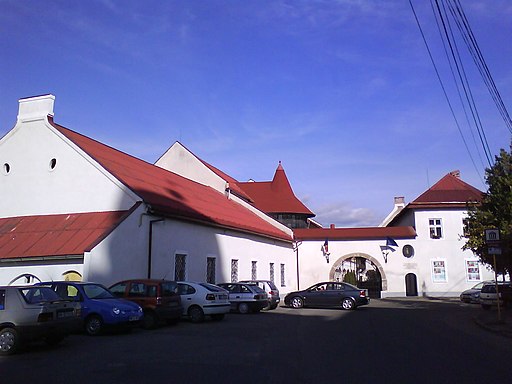Former Coin Mint, Museum of History and Archeology of Máramaros County
Muzeul Județean de Istorie și Arheologie Maramureș
Former Coin Mint, Museum of History and Archeology of Máramaros County
Muzeul Județean de Istorie și Arheologie Maramureș
Original function:
coin mint
Address:
Strada Monetăriei 1-3
Historical Hungarian county:
Szatmár
GPS coordinates:
47.6618374053, 23.5821062453
History
The museum is located in the former coin mint complex.
The two predecessor settlements of the town, Zazarbánya and Asszonypataka, were populated in the 13th century by German goldsmiths and miners. In 1374, King Louis I of Hungary placed the precious metal production of Asszonypataka and Felsőbánya under the administration of a common chamberlain, which later became the minting chamber. In 1411, there was already a mint in the town. In 1468, King Matthias of Hungary leased the mints of Nagybánya, Offenbánya and Nagyszeben to the town for 13,000 gold forints. In the 16th century, with the decline of royal power, minting was taken over by private rentees. At the end of the 16th century, the town was granted to the Báthory family by the emperor, and thus came under the control of the princes of Transylvania. Most of the princedom's money was minted here. In 1620, Prince Bethlen Gábor of Transylvania leased the coin mint to the town. In 1661, Pasha Ali of Várdad forced the town to pay tribute. In the Treaty of Vasvár of 1664, Prince Apafi Mihály I of Transylvania lost the town to the Habsburgs. In 1674, the mining chamber was closed and ore production was placed under the administration of the Mining Directorate of Kassa. During the Hungarian War of Independence led by Rákóczi Ferenc II, the prince minted money here, and after the defeat of Zsibó in 1705, Rákóczi moved the coin mint to Munkács. Between 1734 and 1739, the mint was rebuilt in Baroque style. In 1748, the Chief Mining Inspectorate was established. In 1782 the mint building was enlarged to its present size. In the second half of the 19th century, the Mining Inspectorate was transformed into the Mining Directorate of Nagybánya. In 1864, the mint burnt down and was never reopened, as its importance had also declined.
The museum was established by the Nagybánya Museum Association, founded in 1899 by Schönherr Gyula, a member of the Hungarian Academy of Sciences. In 1904 the town museum was opened with the collected objects. By 1914, it boasted 11,489 objects. Today it is part of the Máramaros County Museum.
{"item":"sight","set":{"sightId":1141,"townId":55,"active":2,"name_LO":"Muzeul Jude\u021bean de Istorie \u0219i Arheologie Maramure\u0219","address":"Strada Monet\u0103riei 1-3","mapdata":"1|627|257","gps_lat":"47.6618374053","gps_long":"23.5821062453","religion":0,"oldtype":"116","newtype":"98","homepage":"https:\/\/www.muzeubaiamare.ro\/","openinghours":"https:\/\/www.muzeubaiamare.ro\/informatii-utile\/","muemlekemlink":"https:\/\/www.muemlekem.hu\/hatareset\/Penzverde-Nagybanya-1530","csemadoklink":"https:\/\/lexikon.adatbank.transindex.ro\/muemlek.php?id=387","picture":"\u003Ca title=\u0022Danielaiulia, CC BY-SA 3.0 RO \u003Chttps:\/\/creativecommons.org\/licenses\/by-sa\/3.0\/ro\/deed.en\u003E, via Wikimedia Commons\u0022 href=\u0022https:\/\/commons.wikimedia.org\/wiki\/File:Monetaria_-azi_Muzeul_Jude%C5%A3ean_de_Istorie_-_Baia_Mare.jpg\u0022\u003E\u003Cimg width=\u0022512\u0022 alt=\u0022Monetaria -azi Muzeul Jude\u0163ean de Istorie - Baia Mare\u0022 src=\u0022https:\/\/upload.wikimedia.org\/wikipedia\/commons\/thumb\/f\/f0\/Monetaria_-azi_Muzeul_Jude%C5%A3ean_de_Istorie_-_Baia_Mare.jpg\/512px-Monetaria_-azi_Muzeul_Jude%C5%A3ean_de_Istorie_-_Baia_Mare.jpg\u0022\u003E\u003C\/a\u003E","picture_ref":"\u003Ca href=\u0022https:\/\/commons.wikimedia.org\/wiki\/File:Monetaria_-azi_Muzeul_Jude%C5%A3ean_de_Istorie_-_Baia_Mare.jpg\u0022\u003EDanielaiulia\u003C\/a\u003E, \u003Ca href=\u0022https:\/\/creativecommons.org\/licenses\/by-sa\/3.0\/ro\/deed.en\u0022\u003ECC BY-SA 3.0 RO\u003C\/a\u003E, via Wikimedia Commons","name":"Former Coin Mint, Museum of History and Archeology of M\u00e1ramaros County","note":"","history":"The museum is located in the former coin mint complex.@\nThe two predecessor settlements of the town, Zazarb\u00e1nya and Asszonypataka, were populated in the 13th century by German goldsmiths and miners. In 1374, King Louis I of Hungary placed the precious metal production of Asszonypataka and Fels\u0151b\u00e1nya under the administration of a common chamberlain, which later became the minting chamber. In 1411, there was already a mint in the town. In 1468, King Matthias of Hungary leased the mints of Nagyb\u00e1nya, Offenb\u00e1nya and Nagyszeben to the town for 13,000 gold forints. In the 16th century, with the decline of royal power, minting was taken over by private rentees. At the end of the 16th century, the town was granted to the B\u00e1thory family by the emperor, and thus came under the control of the princes of Transylvania. Most of the princedom's money was minted here. In 1620, Prince Bethlen G\u00e1bor of Transylvania leased the coin mint to the town. In 1661, Pasha Ali of V\u00e1rdad forced the town to pay tribute. In the Treaty of Vasv\u00e1r of 1664, Prince Apafi Mih\u00e1ly I of Transylvania lost the town to the Habsburgs. In 1674, the mining chamber was closed and ore production was placed under the administration of the Mining Directorate of Kassa. During the Hungarian War of Independence led by R\u00e1k\u00f3czi Ferenc II, the prince minted money here, and after the defeat of Zsib\u00f3 in 1705, R\u00e1k\u00f3czi moved the coin mint to Munk\u00e1cs. Between 1734 and 1739, the mint was rebuilt in Baroque style. In 1748, the Chief Mining Inspectorate was established. In 1782 the mint building was enlarged to its present size. In the second half of the 19th century, the Mining Inspectorate was transformed into the Mining Directorate of Nagyb\u00e1nya. In 1864, the mint burnt down and was never reopened, as its importance had also declined.@\nThe museum was established by the Nagyb\u00e1nya Museum Association, founded in 1899 by Sch\u00f6nherr Gyula, a member of the Hungarian Academy of Sciences. In 1904 the town museum was opened with the collected objects. By 1914, it boasted 11,489 objects. Today it is part of the M\u00e1ramaros County Museum.","town":{"townId":55,"name_HU":"Nagyb\u00e1nya","name_LO":"Baia Mare","seolink":"nagybanya-baia-mare","oldcounty":24,"country":4}},"language":"en","region":"romania","regionid":4,"offer":[],"gallery":false,"album":false}

